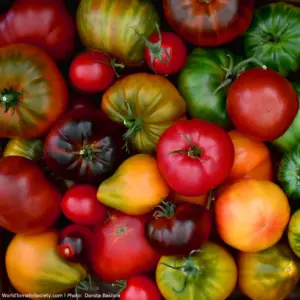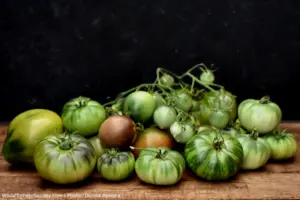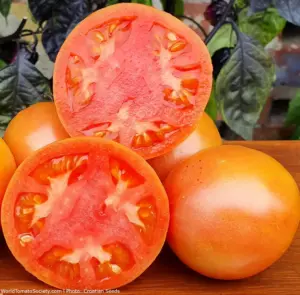
Towards the end of the growing season when the weather compels us to collect all the remaining tomatoes before the frost takes its toll, whether ripe or not, it’s essential to know how to store them.
Below, you’ll find practical guidance to harvesting and preserving tomatoes and how to ensure your tomatoes remain fresh and delicious for the next several weeks or even months.
When collecting tomatoes for extended storage, remove any stems that may still be attached to the tomatoes, check to be sure all fruits are free of damage, and thoroughly wash and dry each one carefully. These steps will help to prevent rot during storage. Then, sort them according to the following guidelines:
Tomatoes ripen best at room temperature. If you want them to ripen quickly, place them in a basket or on a shelf in an area with a temperature around 64-70°F/18-21°C. If you want to expedite ripening further, place them in a paper bag along with an apple or a banana. These fruits release ethylene gas, which accelerates the ripening process of tomatoes.
For tomatoes you wish to store for a longer period and slow down their ripening, keep them in a cooler room (temperatures no lower than 50°F/10°C) while avoiding direct sunlight. Exposure to sunlight can speed up ripening and reduce the shelf life of the fruit.
Check the tomatoes every few days, removing any that begin to ripen or show signs of spoilage to prevent the spread of mold.

Some of the tomatoes that didn’t have the chance to ripen fully before the season’s end can be harvested and transformed into delicious preserves. Here are a few ideas:
*Visit the recipe section on our website for more ways to utilize green tomatoes- you’ll find both sweet and savory recipes.
Apart from early, mid-season, and late varieties, there are also tomato varieties that are genetically predisposed to long-term storage. Two groups of varieties can be distinguished here – the first consists of varieties that store well as ripe fruits and can sit at room temperature for several weeks after being picked from the plant without losing their flavor. They can be stored even longer in cooler conditions. Two examples of such varieties are “Piennolo del Vesuvio”, and “Vesuvio Giallo”, which are originally from Italy, grown in the volcanic, mineral-rich soil near Mount Vesuvius. These tomatoes are collected in clusters, tied up, and hung in cool, well-ventilated areas, allowing them to be stored until the following spring. They have thick skin and meaty flesh, making them excellent for long-term storage.

Another category of tomatoes suitable for extended storage is those possessing the alcobaca (alc) gene. These are known as “long keeper” varieties and include “Mystery Keeper”, “Pomodoro Ponderosa”, “Reverend Morrow’s Long Keeper”, “Zhiraf”, “Long Keeper”, “Gialleto Brindisino”, or “Colgar de Mala Cara”. They are harvested unripe and are genetically determined by an interior-to-exterior ripening process. Fruits undergo changes that prevent them from softening and drying. Typically, they reach peak flavor around 2 months after harvest, and from that point on flavor begins to decrease. Long keepers are kept well in a pantry, layered with paper in a cardboard box.
It is worth considering planting a few extra plants from both of these two groups next spring. If you organize your tomato crops properly, select varieties with different ripening times, and add a few with good long-storage capability, your harvests will become a joyful way to savor the taste of summer throughout the entire year!
Great article! Thank you for all the tips. I had both, Piennolo del Vesuvio and Vesuvio Giallo and they are really great for long storage. Next year want to try long keepers too.
Wow. I’ve never heard about ‘long keeper’ tomato varieties. How do they differ from regular tomatoes in terms of sowing?
Thank you, Konrad. We hope you will enjoy the taste of your own tomatoes for weeks or even months!
Hi Etienette, Long Keeper-type tomato varieties should be sown indoors, like other varieties, approximately 6-8 weeks before the last spring frost. Thank you!
This is great information. I grew Japanese Black Trifele this year. I dry-farm them and the skins are very tough–I have to peel them before eating. They seem to be staying fresh for a long time after picking.
Hi JJ, thank you for sharing your experience about tomatoes grown with limited watering! They also are less susceptible to damage because they contain less water. It improves their ability to be stored longer. Happy gardening JJ!
enjoyed the info. my dad used to grow a long keeper 25 years ago. don’t know the name. probably from burpee. thanks
Hi Nancy, glad you found the info useful! Long Keeper tomatoes have a special place in many people’s memories and gardens, and it’s great to hear about your dad’s experience with them. Happy gardening!